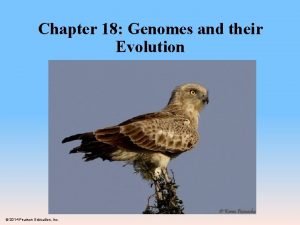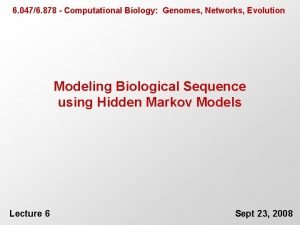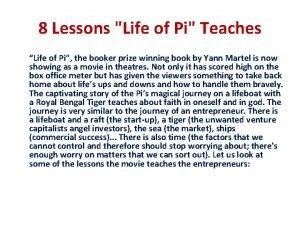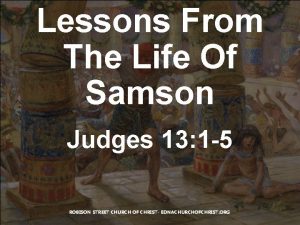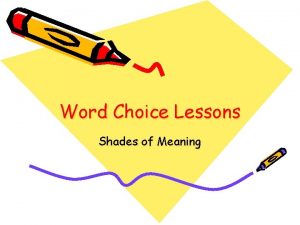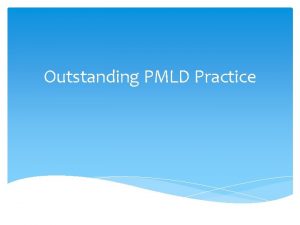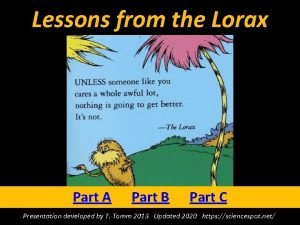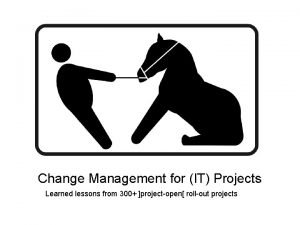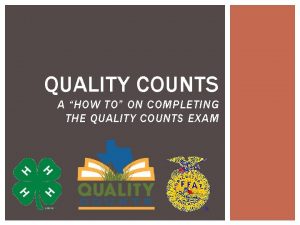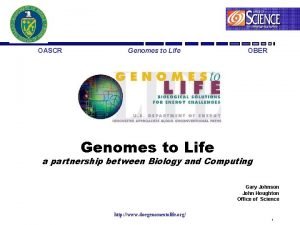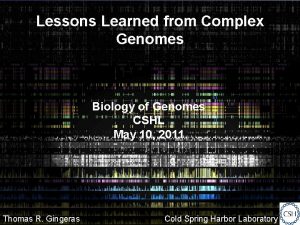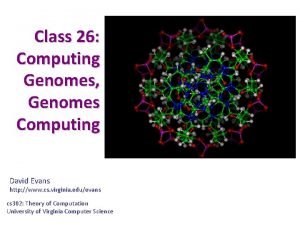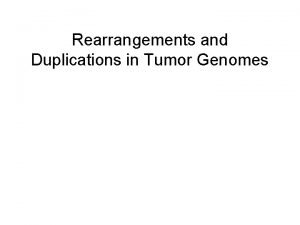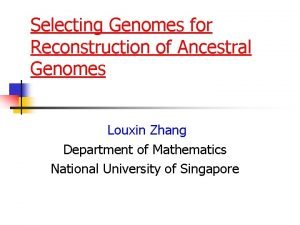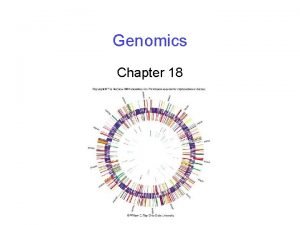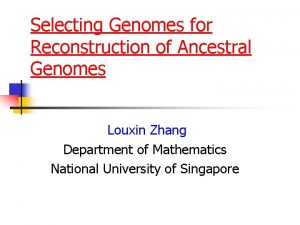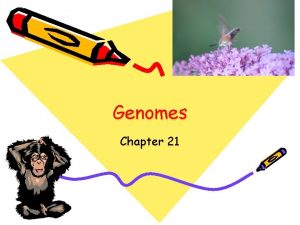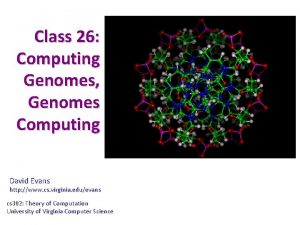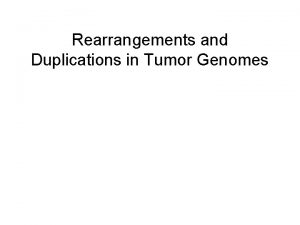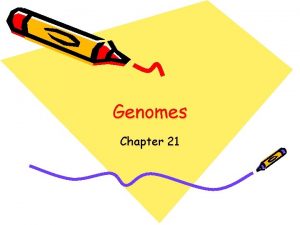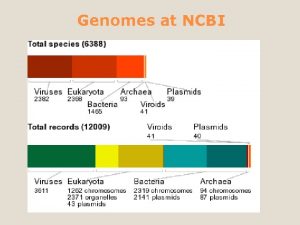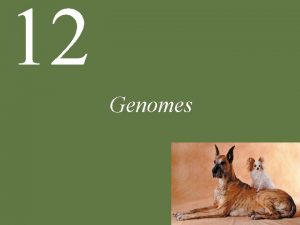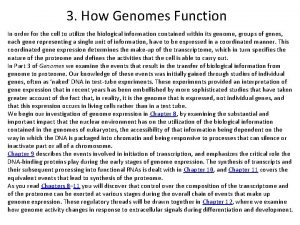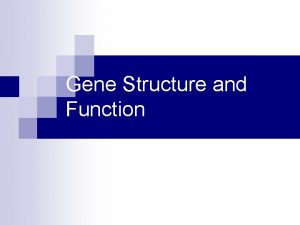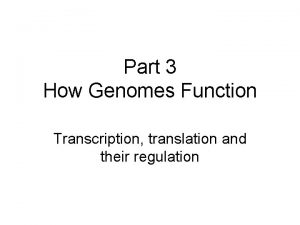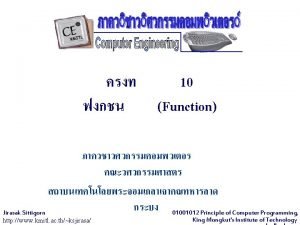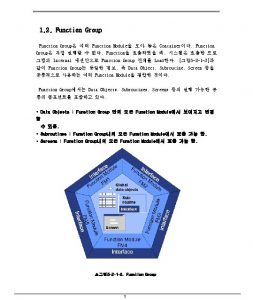software of life Genomes to function Lessons from























































- Slides: 55

“software” of life

Genomes to function

Lessons from genome projects • Most genes have no known function • Most genes w/ known function assigned from sequence-similarity matches to other organisms • Need methods to experimentally assay gene activity on a genome-wide scale

Measure expression on genome-wide scale: DNA Microarrays Condition 1 RNA gene enriched in condition 1 Condition 2 RNA gene enriched in condition 2 17, 997 genes 94% of genome

Global Analyses of Gene Expression • Collect all microarrays from the world • Gene activity across thousands of conditions genes (20 k) conditions (~5 k)

Digital Age of Biology • Biologists drowning in data • Bottleneck now is developing computational resources for discovery • Think Genbank before BLAST. . .

Discovering Gene Function on a Global Scale • Gene Networks • Search Engines

Gene Networks Matt Weirauch. Martina Koeva Corey Powell Charlie Vaske Alex Chad Williams Chen

Gene Networks • link 2 genes together if they are co-activated in multiple organisms • build networks from all the links • discover function from a gene’s links • understand bigger picture of gene regulation

Principle #1 Gene networks are “scale free”

• Scale free – gene networks may arise from processes like expansion of WWW some links on the WWW

Principle #2 Genes self assemble into modular subcomponents

http: //www. cse. ucsc. edu/~jstuart/multispecies

Principle #2 Genes self assemble into modular subcomponents

Principle #3 Coordinated activity is a signature of gene function fatty acid protein modification metab. respiration tissue growth ribosomal subunits cell polarity, ribosome cell structure biogenesis neuronal transcription secretion development / hox genes Newly evolved immune response proliferation

Proteasome “module” http: //www. cse. ucsc. edu/~jstuart/multispecies

Principle #4 Local network topology reports on gene function integrator subunits

top 3 integrators:

Integrators have more cis-regulatory complexity integrators subunits

integrators have different phenotypes

Current Directions for Gene Networks • Gene isoform networks to capture alternative splicing • Predict drug targets from synthetic lethal nets

Current Directions for Gene Networks • Gene isoform networks to capture alternative splicing • Predict drug targets from synthetic lethal nets (w/ Lokey Lab)

Gene Isoform Networks Matt Weirauch. Martina Koeva Corey Powell Charlie Vaske Alex Chad Williams Chen

Gene Isoform Networks • Most human genes (>60%) are alternatively spliced. • Alternative splicing gives rise to different proteins from the same gene • The particular variant expressed can be very important (e. g. sex determination in flies) • The functional implications of alt. splicing in humans is still largely unexplored. • Provides a higher resolution understanding of gene expression and its relationship to health & disease

Splicing Microarrays • Measure particular subparts of the gene structure (e. g. exon-exon junctions) • Data now available for human and mouse tissue compendiums • Infer isoforms from expression of subparts across the tissues • Identify isoform modules

A functional network of gene isoforms isoform patterns isoform network • assemble into modules • functional signatures • global network design

Search Engines Matt Weirauch. Martina Koeva Corey Powell Charlie Vaske Alex Chad Williams Chen

Search engines to discover gene function

identify every member of a pathway Retinoblastoma pathway

(slide from Art Owen)

gene recommender search for regulating conditions query

gene recommender search for regulating conditions query

gene recommender regulating conditions query search for new candidates

gene recommender regulating conditions query + “hits”

gene recommender procedure query Rb hda-1 lin-36 rba-2 lin-9 hits 1 Score experiments 2 Score genes dpl-1 rba-2 K 12 D 12. 1 Rb R 06 C 7. 8 hda-1 B 0464. 6 R 06 F 6. 1 T 16 G 12. 5 F 55 A 3. 7 plk-1 lin-9 lin-36

computational validation hits query (no Rb) hda-1 lin-36 rba-2 lin-9 1 Score experiments 2 Score genes 1. rba-2 2. lin-9 3. dpl-1 4. R 06 C 7. 8 5. hda-1 6. B 0464. 6 7. R 06 F 6. 1 8. K 12 D 12. 1 9. T 16 G 12. 5 10. F 55 A 3. 7 11. plk-1 12. Rb 13. lin-36

Searching 1 organism

Multiple Species Search Engine Cell hits Cell Euk hits Euk Opis hits Opis H. sap query Anim hits Ecdy hits H. sap D. mel hits D. mel C. ele hits C. ele S. cer hits S. cer Ortholog Map A. tha hits A. tha H. pyl hits

H. sap BTPs of D. mel hits D. mel H. sap cell cycle query Cdk 4 Mcm 5 Mcm 7 E 2 f Mus 209 Rpd 3 … CDK 4 MCM 5 MCM 7 E 2 F 1 PCNA HDAC 1 … GR Hdac 1 Bub 1 Mcm 6 Rpa 1 Mcm 3. . . HDAC 1 (3) BUB 1 (21) MCM 6 (26) RPA 1 (48) MCM 3 (60). . . Orthology Map GR H. sap GR Ecdy H. sap BTPs of C. ele hits C. ele cdk-4 mcm-5 mcm-7 n/a pcn-1 hda-1 … Ecdy hits mcm-3 rpa-1 mcm-6 bub-1 rba-2 hda-1. . . MCM 3 (6) RPA 1 (9) MCM 6 (15) BUB 1 (24) RBBP 4 (25) HDAC 1 (114). . . Anim hits H. sap hits MCM 3 (8) MCM 6 (9) MCM 5 (28) HDAC 1 (69) RBBP 4 (86) RPA 1 (428) BUB 1 (1866). . . MCM 6* (1) BUB 1* (2) HDAC 1* (3) MCM 3* (4) RPA 1 (5). . . Anim MCM 3* (1) MCM 6* (2) HDAC 1* (3) MCM 5* (4) RBBP 4 (5). . .

Related genes sort to the top of the search lists

Multiple species search is more precise

Multiple species search is more precise


immunological synapse Gene product Comment CD 8 antigen query unknown tyrosine kinase lymphocyte specific T-cell receptor zeta query CD 2 antigen participates in T-cell activation CD 4 antigen (p 55) query unknown Src-like adaptor negative regulator of T-cell receptor signaling CD 8 antigen query unknown transcription factor T-cell specific paired box gene 8 (PAX 8) new association

7 21 17 1 34 28 2 26 14 5 11 42 22 12 3 4 36 15572 15571 24 23

Search Engine Directions • Search gene networks for pathway members – Incorporate multiple data sources in search – Faster than scanning raw data • Discriminative search engines – E. g. identify genes coregulated with DNA damage genes more so than S-phase genes

Search Engine Directions • Network Recommender – Search gene networks for pathway members – Incorporate multiple data sources in search – Faster than scanning raw data • Discriminative search engines – E. g. identify genes coregulated with DNA damage genes more so than S-phase genes

Network Recommender Matt Weirauch. Martina Koeva Corey Powell Charlie Vaske Alex Chad Williams Chen

Network Recommender coexpression physical protein interactions synthetic lethal

Iterative Propagation Algorithm 1. Given a set of genes in a pathway A 2. Score gene g based on how connected to predicted pathway members in network i 1. 2. Si(g) = hwighp(h) / hwigh, where h ranges over neighbors of g in network i 3. Compute posterior each gene g in pathway 1. 2. Construct a positive distribution P(Si(g)| g in A) Construct a negative distribution P(Si(g)| g not in A) 4. Set p(g) = ∏i P(g in A | Si(g))

precision Network Recommender Performance recall

Network Recommender Results

Network Recommender for cell cycle - physical protein interaction - gene coexpression

Supplemental Material

Genetic interactions
 Chapter 18 genomes and their evolution
Chapter 18 genomes and their evolution Computational biology: genomes, networks, evolution
Computational biology: genomes, networks, evolution Things i learned in the story of pi
Things i learned in the story of pi Judges 13 lesson
Judges 13 lesson Deconstructionism definition
Deconstructionism definition Lessons from the life of prophet samuel
Lessons from the life of prophet samuel Joseph life lessons
Joseph life lessons What we can learn from ant
What we can learn from ant 45 life lessons
45 life lessons Lessons from the life of moses
Lessons from the life of moses Lessons from the life of judas iscariot
Lessons from the life of judas iscariot Soda countable or uncountable
Soda countable or uncountable Life lessons from the tower of babel
Life lessons from the tower of babel Life lessons from the book of job
Life lessons from the book of job 5 lessons from a pencil
5 lessons from a pencil Lessons from absalom life
Lessons from absalom life Word choice lessons
Word choice lessons Tone diction imagery
Tone diction imagery Vex iq lessons
Vex iq lessons Tinkercad lessons for middle school
Tinkercad lessons for middle school Characteristics of the shunammite woman
Characteristics of the shunammite woman How does the narrator convey a mixed attitude toward gatsby
How does the narrator convey a mixed attitude toward gatsby The five people you meet in heaven lessons
The five people you meet in heaven lessons Lessons from the ten plagues of egypt
Lessons from the ten plagues of egypt Moscow art theatre
Moscow art theatre Python turtle lessons
Python turtle lessons The teacher assigns homework after 3/4 of the lessons
The teacher assigns homework after 3/4 of the lessons Outstanding pmld lessons
Outstanding pmld lessons Voice lessons nancy dean
Voice lessons nancy dean Lessons learned faa
Lessons learned faa The lorax quotes
The lorax quotes Naaman healed of leprosy lesson
Naaman healed of leprosy lesson Lessons from the rich young ruler
Lessons from the rich young ruler Leadership lessons from chak de india
Leadership lessons from chak de india Lessons from the geese
Lessons from the geese Hyatt regency walkway collapse
Hyatt regency walkway collapse Lessons from hadith 18 of annawawis collection
Lessons from hadith 18 of annawawis collection The lord visited sarah
The lord visited sarah Change management lessons learned
Change management lessons learned Lessons from acts 14
Lessons from acts 14 Courage zone 7 habits
Courage zone 7 habits Lessons from the eagle
Lessons from the eagle Workday implementation lessons learned
Workday implementation lessons learned Voice lessons: tone answers
Voice lessons: tone answers What are the three lessons of joe flom
What are the three lessons of joe flom Spike lessons
Spike lessons Spike prime fll robot design
Spike prime fll robot design Spike lessons
Spike lessons Quality counts login
Quality counts login Prime lessons.org
Prime lessons.org Pngc
Pngc Missouri school counseling curriculum
Missouri school counseling curriculum Mindup cost
Mindup cost Scriptures on forgiveness
Scriptures on forgiveness Lessons from obadiah
Lessons from obadiah Proverbs 30:24-28 meaning
Proverbs 30:24-28 meaning
